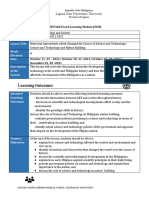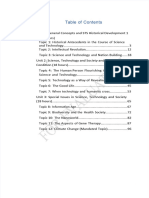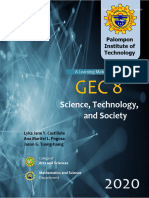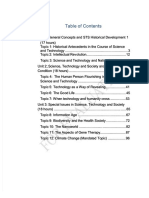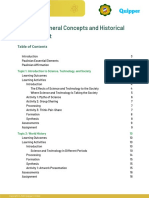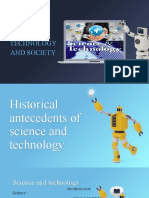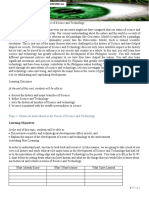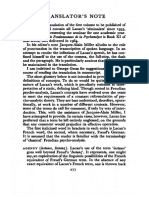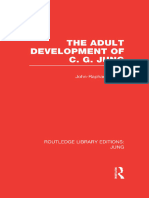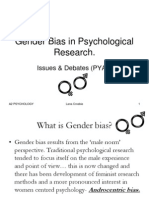STS-Module Unit 1
Uploaded by
rsevrseSTS-Module Unit 1
Uploaded by
rsevrseForeword
The completion of this module in Science Technology and Society is a result
of the mutual desire of Cagayan State University and the authors to help
students gain deeper insights on the impact of Science and Technology to the
society and make them significantly literate about societal issues that had
arisen due to changes in Science and Technology.
To achieve this goal, we banked on:
a. the CHED Memorandum Order (CMO) Number 20, series of 2013;
b. the summarized feedback from CSU Peace Corps Volunteers as well
as the members of technical evaluators
c. the consensus arrived at by the authors in the series of module write
shop sessions that are specifically conducted by the institution for this
purpose
Details of the module include:
1. The activation of prior knowledge of students through various
activities. This section would allow students make use of their schema
where new knowledge can be built on.
2. History on the development different technologies that are succinctly
explained. This leads to understanding of the current state of Science
and Technology both in the global and national scale. Interaction of
Science and Technology with social, political, cultural, economic and
philosophical needs of people is given equivalent weight.
3. Enrichment activities were carefully chosen in order help students
develop the 4Cs of the 21st Century Skills. Activities require students’
critical thinking as well be asked to solve real life problems t. Further,
this module contains learning task that will stimulate student’s
creativity as some of the activities are purposefully designed for
students to be able to showcase their multiple intelligences. Also,
majority of the activities are geared towards honing abilities of learners
to work collaboratively and communicating effectively
4. The application of fundamental laws of science as well as latest
invention, recent technology, research-based discoveries are given
prominence.
5. Multiple forms of feedback and/or assessment methods are also
included in this module. Also, students are given the chance to reflect
on the knowledge that they have learned at the end of each unit.
6. Emphasis on ecology and concern for the environment is also being
underscored in this material. This has become more relevant with the
global issue on climate change, global warming and environmental
degradation. On a personal note, Philippines is not exempted from
these concerns with runaway issues on population explosion and the
general apathy of the Filipinos and even government leaders when it
comes to environment.
While it is nature of Science to continuously create breakthrough in
the form of technology, there is a strongly felt need to offer a course
Science, Technology and Society Module 1
that will help students evaluate the moral and ethical implications and
relevance of these feat to our lives. We hope that, even in the smallest
ways, we can contribute to the realization of this necessity.
-The Authors
Science, Technology and Society Module 2
Unit 1:
General Concepts and
STS Historical Development
(17 hours)
Introduction
Human creativity is beyond limit that even our ancestors might not have
imagined that our status of science and technology would be as robust as
today. Our current understanding about the nature and the world is a result of
constant over throwing of paradigm wherein an old paradigm like Geocentric
Model is replaced by a paradigm that has a higher content and explanatory
power like the Heliocentric Model. Such is termed scientific revolution. This
is just one of the many theories that were challenged in the history of Science
and have helped shaped our society.
Development of Science and Technology does not only leave indelible impact
in the history but its trail can be traced by its influence in our society and
country as a whole. In this unit, you will learn how science and technology has
greatly influenced the development of the Philippine society. You will
evaluate different government policies and programs to see how they have
shaped the nation. You will also learn significant inventions and projects
accomplished by Filipinos that greatly develop the countries’ science and
technology, and have been a major contributor to the Philippine nation-
building.
This unit will allow you to time travel through the antecedents of science and
technology; lets you investigate how the present status of science and
technology came into being, and explore the major turns in the course of
global and national history that led it to its exhilarating and captivating
development.
Learning Outcomes
At the end of this unit, students will be able to:
Discuss the interactions between S&T and society throughout history;
Science, Technology and Society Module 3
Discuss how scientific and technological developments affect society
and the environment;
Discuss the paradigm shifts through history;
Explain how intellectual revolution change the way how humans see
the world;
Describe the technological advancements that happened in the
information age;
Explain the role of Science and Technology in Philippine nation
building;
Evaluate government policies pertaining to science and technology in
terms of their contributions to nation building; and
Identify actual science and technology policies of the government and
appraise their impact on the development of the Filipino nation.
Science, Technology and Society Module 4
Topic 1: Historical Antecedents in the Course of Science and Technology
Learning Objectives
At the end of this topic, students will be able to:
Discuss how scientific and technological developments affect society;
and
Explain the impact of the development of science and technology to
the environment
Activating Prior Learning
In order to understand past, one has to look back and revisit it. In like manner,
we are going to take a look at our very rich history and study what are the
major turns in the development of Science and Technology that had led us to
the innovation of cutting edge and sophisticated Technology in the present.
Your task is to fill in the K-W-L chart below by jotting down what you have
known and what are the things that you would like to know about our
historical antecedents in terms of Science and Technology.
What I already Know What I Want to know What I have Learned
Presentation of Contents
Science and Technology in Ancient Times
In the ancient times, people were concerned with transportation and
navigation, communication and record keeping, mass production, security and
protection, as well as health, aesthetics and architecture. Science and
Technology keeps on advancing in order to meet the growing needs of people
along these areas. Due to the constant innovation introduced by Science and
Technology, which has the end goal of improving lives and making the work
easier, faster and efficient, our society respond by changing as well. These
Science, Technology and Society Module 5
changes are evident as each ancient civilization keep on creating technology
that has been modified and that is being used today.
To name a few, Sumerian are known for their contribution with the first
writing system called as cuneiform. Challenge to mass produce food, they
invented plowing, irrigation and dikes and wheel for farming. Throughout the
existence of this civilization, their main mode of transportation was through
waterways such as rivers and seas. They are also known to develop the first
road.
Figure 1.1 Sumerian Cuneiform ("Redirect Notice",
2019)
On the other hand, Babylonian
civilization, which emerged near
Tigris and Euphrates River were
famous for being great builders,
engineers and architects. One of
major contributions is the
hanging garden of Babylon
which one of the seven wonders of
the world.
Figure 1.2 Hanging Garden of Babylon ("Image: Hanging
Gardens of Babylon - Wikipedia", 2019)
Another civilization that is known for its renowned archeological artifact like
the death mask of Tutankhamen and Pyramid of Giza is the Egyptian
Civilization. Also, ancient Egyptians are known for their earlier contributions
like water clock or clypsedra, paper or papyrus, ink and a system of writing
known as hieroglyphics. They have also invented cosmetics for aesthetic
reason. Meanwhile, during this time, wigs were worn by wealthy Egyptians to
protect the shave of the heads from the harmful rays of the sun.
Science, Technology and Society Module 6
Figure 1.4 Pyramid of Giza ("Google Image
Figure 1.3 Death Mask ("Google
Result for
Image Result for
https://cdn.images.express.co.uk/img/dynami
https://www.timetrips.co.uk/ep-
c/25/590x/Can-you-see-the-flaw-682241.jpg",
tutmask1.jpg", 2019)
2019)
Figure 1.5 Papyrus ("Image:
Figure 1.6 Hieroglyphics ("Image:
Papyrus in Ancient Egypt | Essay |
Hieroglyph | writing character |
Heilbrunn Timeline of Art ...", 2019)
Britannica.com", 2019)
Apart from being the birthplace of western philosophy, some of the major
achievements of Greeks include in-depth works on Philosophy and
Mathematics. They are also celebrated for their contribution to the world like
coliseum, Olympics, alarm clock and water mill.
Science, Technology and Society Module 7
1.7 Olympics ("Image: Figure 1.6 Greek Coliseum
lympic Games ("Image: the coliseum (greece) -
ory.org]", 2019) YouTube", 2019)
Perceived to be the strongest political and social entity in the west, Roman
Empire was considered to be the cradle of politics and governance. Other
civilizations looked up to it as a model in terms of codified laws and
legislation. They are also celebrated for the invention of newspaper, bound
books or codex. In terms of architecture and engineering, Romans are known
for building elaborate churches, basilicas, aqueducts, coliseums, amphitheaters
and residential houses. They have also devised their own number system
which is the Roman Numeral System.
Figure 1.8 Roman numeral system Figure 1. Roman aqueduct
("Google Image Result for ("Image: Roman Aqueducts—
http://historylearning.com/fileadmin/ Ancient Engineering Marvels",
user_upload/roman-numerals.jpg", 2019)
2019)
Considered to be the oldest civilization in Asia, China is known for the silk
trade, tea production, gun powder and the living legend great wall of China.
Science, Technology and Society Module 8
Figure 1.10 Silk Road ("Image: Silk Figure 1.11 The Great Wall of
Road - HISTORY", 2019) China ("Image: Great Wall -", 2019)
Science and Technology in Middle Ages
The start of the middle ages was marred by massive invasions and migrations.
Wars are prevalent during this time. As such, great technology was needed in
the fields of weaponry, navigation, food and farm production and health. The
wars have resulted to population decline. However, in the later part of this
period, there was significant increase in population. Trade and commerce
among nations increased, which resulted in greater demands for transportation
technology. Some of the most innovative minds came from this period.
To facilitate record keeping, woodlock printing developed by Chinese was
improved by the time of Johann Gutenberg with a cast type printing press.
This general invention soon evolved to be the mechanical printing press which
was eventually used all over the world. The printing press was invented to
address the need for publishing books that would spread information to many
people at a faster rate. This invention also made works accessible to
individuals who could not even write (Streissguth, 1997).
Figure 1.12 Johann Gutenberg Printing Press ("Image: Johannes
Gutenberg Printing Press Stock Photos & Johannes ...", 2019)
Science, Technology and Society Module 9
Another invention in the Middle Age is the microscope. Growing populations
caused massive migration and urbanization during the period. More and more
people transferred to polluted and populated urban areas which resulted in
more people getting sick. With this, experts needed to a device to study
microorganisms in order to develop proper medicines for illnesses. Guided by
the principles used for the invention of eyeglasses in earlier years, Zacharias
Janssen was able to develop the first compound microscope (Davidson, 2015).
Figure 1.13 Zacharias Janssen’s Microscope ("Image: Molecular
Expressions Microscopy Primer: Museum of Microscopy ...", 2019)
Since the Middle Age was also known as the Age of Exploration, the need for
nautical inventions was high. The invention of the telescope, an optical
instrument that helps in the observation of remote objects, was a great help for
navigators during this time.
Great development in the weaponry technology also occurred in this era. This
include cross bows and long bows. Additionally, in close range hand-to-hand
combat, soldiers should wear something to protect themselves, a need
addressed by the creation of iron body armors. However, body armors were
heavy and limited the movements of the soldiers, chainmail was invented to
solve the problem.
Science and Technology in Modern Times
The booming world population during the nineteenth century onwards
demanded that more goods be produced at faster rate. People needed efficient
means of transportation to trade more goods and cover a larger distance.
Machines that required animals to operate must thus be upgraded. Faster and
easier means to communicate and compute should be developed to establish
connections between and among nations. All these needs resulted in the
development of industries. However, due to massive industrialization, the
modern times again faced more complicated problems. Food processing and
medicine posed some of the bigger challenges since health was of great
concern.
Science, Technology and Society Module 10
As people were able to develop better means of production to meet the needs
of the population, food preservation and food safety became an issue. Louis
Pasteur, a French biologist, microbiologist and chemist found a way to solve
the problem. He invented pasteurization, the process of heating dairy products
to kill the harmful bacteria that allow them to spoil faster. Through this
process, milk could be stored and consumed for a longer period. It also
prevented illnesses caused by harmful bacteria (Macalester College, 2010).
Other contributions of Pasteur to Science and Technology and Medicine
included his works on molecular asymmetry, fermentation and vaccination.
The modern times demanded better means of powering homes and
transportation. This led to the development of kerosene and the petroleum
refinery industry (Skrabec, 2010). At present, petroleum is widely used in
powering automobiles, factories and power plants, among others.
The more people got connected by trade and exploration, the more they
needed a way to easily maintain these connections and communicate with each
other in real time. Governments likewise needed some kind of communication
system which would allow them to administer their states well. Important day-
to-day decisions must be discussed and addressed at the fastest time possible.
Thus, the invention of telephone by Alexander Graham Bell was one of the
most important inventions at that time.
Figure 1.15 Alexander Graham Bell’s Telephone ("Image: Inventor of the
Telephone: Alexander Graham Bell - Learning History", 2019)
Although an earlier version of the calculator had already been developed,
circumstances in the modern times required a faster way to compute more
complicated equations. Computing devices must also be easy to carry since
they would be utilized on a day-to-day basis. The creation of modern
calculators did not only pave the way for easier arithmetic calculations, but
also resulted in the development of more complex processing machines like
computer.
Science, Technology and Society Module 11
Application
Your task
1. Write down the top 10 invention in the World and in the Philippines
2. Determine persisting needs which were addressed by each invention
3. Discuss briefly the impact of each invention to society
Feedback
1. Fill in “What I have Learned” column by writing down what you have
learned from this topic
What I already Know What I Want to know What I have Learned
Science, Technology and Society Module 12
2. Create a collage on the inventions in the Philippines and the world
Science, Technology and Society Module 13
Topic 2: Intellectual Revolution
Learning Objectives
At the end of this topic, students will be able to:
Discuss paradigm shifts through history;
Explain how intellectual revolution changed how humans see the world;
and
Select a revolutionary scientist and present a persuasive speech
representing his/her theory
Activating Prior Learning
You may have read about different theories that worked and were believed to
be true during ancient times. In Astronomy, for example, you have learned
that Sun is the Center of the Solar System and that the planets, including
Earth, are revolving around it in an elliptical orbit. However, people in ancient
times believed that the earth was the center of the universe. Early beliefs also
claimed that human beings were created through “Divine Creation” but this
was replaced by Darwin’s Theory of Evolution by Natural Selection. These
are just some of the examples of early theories that were challenged in the
history of Science.
What were the great Intellectual Revolutions that significantly shaped our
Society? What made these new theories controversial? Who were these people
or groups of people behind these upheavals that permanently changed the
course of history of Science? What were their needs, and what were their
struggles that motivated them to engage in such scholarly contribution?
This topic will lead you to some of the answers of these aforementioned
questions. Moreover, this topic describes how science and technology theories
paved the way for the Enlightenment and our current understanding of some of
the fundamental concepts of Science and of the world.
Science, Technology and Society Module 14
Presentation of Contents
The Man who moved the Sun
The way people think about Solar System has changed many times throughout
history. Before the development of telescope astronomy beliefs were based on
what can be seen by the naked eye. One of the earliest ideas on how Solar
System was structured was introduced by Claudius Ptolemy. He posited that
planets as well as the sun and the moon, moved in a circular motion around the
Earth, a concept which is known as geo-centrism. This geocentric model,
considered to be one of the greatest discoveries of all time, was widely
accepted by the people and became the astronomical dogma in Western
civilization for 1,400 years.
In the 16th century, Nicolaus Copernicus challenged the geocentric model by
putting sun at the center of the solar system and known as the concept of
heliocentrism. This idea was rejected at first by the public. It appalled many
since their religious belief had taught them that the Earth was created first
before all other things. Copernicus was even persecuted as a heretic.
Figure 2.1 Bold Man who challenged the Theory of Divine
Creation ("Image: Occult Science 4.0 - Heliocentric vs.
Geocentric Astrology - YouTube", 2019)
Charles Darwin was an English naturalist who studied variation in plants,
animals and fossils during a five-year voyage around the world in the 19th
century. Darwin's theory of evolution challenged the idea that God made all
the animals and plants that live on Earth in a single day, which contradicted
the commonly held Christian views of his era. He did not publish his scientific
work and ideas until 28 years after his voyage.
Finally, as a result of Darwin's world expedition and observations, which were
enhanced by many years of experimentation, his discussions with like-minded
Science, Technology and Society Module 15
scientists and his developing knowledge of geology and fossils, he proposed
the theory of evolution by natural selection. Darwin proposed that: individual
organisms within a particular species show a wide range of variation for a
characteristic, individuals with characteristics most suited to the environment
are more likely to survive to breed successfully; and the characteristics that
have enabled these individuals to survive are then passed on to the next
generation. This is called Theory of Evolution by Natural Selection
Figure 2.2 Tree of Evolution ("Redirect Notice", 2019)
Science, Technology and Society Module 16
Figure 2.3 Theory of Creation ("Redirect Notice", 2019)
The Father of Psychoanalysis
In the past, the field of Psychology was always classified under philosophy.
Psychology was considered more of an art rather than a science. In the late 19th
century, Sigmund Freud was able to change people’s perception of psychology
with his revolutionary theory of psychoanalysis.
Psychoanalysis is the study of human behavior. In his theory, Freud explained
that there are many conscious and unconscious factors that can influence
behavior and emotions. He also argued that personality is a product of three
conflicting elements: id, ego and superego.
Figure 2.4 Theory of Psychoanalysis ("Redirect Notice", 2019)
Science hardliners brushed off the legitimacy of psychoanalysis as a science
since concepts were viewed as philosophical and supernatural. Many believed
that Freud’s theory has no scientific basis as no empirical or experimental data
could support it.
Science, Technology and Society Module 17
Despite criticisms, Freud still continued to work on refining his theory and in
fact tried to explain how psychoanalysis can be a clinical method in treating
some mental disorders. Soon enough, people were able to understand the
concepts of psychoanalysis, which eventually resulted in classifying
psychology as a science.
Application
What’s New
What we had just studied are the major intellectual revolutions in the past. At
present, what are the widely acceptable theory that could explain
1. Celestial Mechanics
2. Evolution of human beings
3. Psychoanalysis
Science, Technology and Society Module 18
Feedback
Direction: Conduct an interview to non-science majors about intellectual
revolutions and present the synthesis of your interview to the class. (Note:
Kindly prepare an interview schedule prior to the conduct of the interview).
Science, Technology and Society Module 19
Topic 3: Science and Technology and Nation Building
Learning Objectives
At the end of this topic, students will be able to:
Explain the role of Science and Technology in Philippine nation
building;
List noteworthy inventions, with their inventors, and give their major
contributions in shaping the Filipino nation;
Identify science and technology policies of the government;
Appraise the impact of these policies on the development of the
Filipino nation; and
Recognize the need for balance between freedom and responsible
behavior during the exchange of ideas.
Activating Prior Learning
Now, let us see what you know about the role of science and technology by
completing the concept map below. But before that, you may want to watch
the movie clips and read the short article listed below to get some ideas.
Happy watching and reading!
Questions to Ponder:
1. What roles do science and technology play in the developmental
progress of the country?
Watch: 1. Science and Technology: Moving the Philippines Forward
Link: https://youtu.be/9li8S3L5p2Q
2. The State of Science and Technology in the Philippines
Link: https://youtu.be/_ttaqZf-SMg
Read: 1. Ratnasiri, N., 2006. The role of Science and Technology in nation
building. Journal of the National Science Foundation of Sri Lanka,
34(3), p.113. DOI: http://doi.org/10.4038/jnsfsr.v34i3.3640
From your readings and from the videos you watched, complete the diagram
below by enumerating the roles of science and technology in shaping the
nation. Then, choose one from your list and explain it to the class.
Science, Technology and Society Module 20
Role of S & T in
Nation Building
Good job! Let’s learn more as you go through this lesson.
Presentation of Contents
Brief Historical Background of Science and Technology in the Philippines
Pre – Colonial Period
Even before the Spain colonized the country, some indigenous science and
technology has already existed with regards to agriculture like farming, animal
– raising, and the utilization of plants and herbs as medicines. The use of
technology is evident in the in handicrafts, pottery, weaving, and tools used by
ancient Filipinos in their everyday life.
Innovation and ingenuity were unmistakable by the way native Filipinos built
the rice terraces by hand. They also developed tools for planting, hunting,
cooking, fishing, and also for fighting enemies during tribal conflicts. They
used indigenous technology in building houses, irrigations and transportation,
both on land and on waterways.
The ancient practices in science and technology by our ancestors are now
considered as indigenous science or folk science.
Colonial Period
Spanish colonization paved way to modern means of construction. Roads,
bridges, churches, and other large infrastructures were built with more
sophistication using some engineering skills and tools brought by the
Science, Technology and Society Module 21
Spaniards. In addition, Spanish colonizers developed health and education
system in the country.
The American colonial rule modernized almost all aspects of life in the
country. They established the Bureau of Science to initiate the development in
the field of science and technology.
Post – Colonial Period
After achieving independence from the colonial masters, the Philippines,
under different administrations, continued to pursue programs in science and
technology. Each leadership had its own S&T agenda. However, it is
important to note that some Philippine presidents introduced more
developments in the field than others, which you will find out soon as you
course through this topic.
Filipino Presidents and their Contributions in the Development of Science
and Technology in the Philippines
Philippine Presidents and the Status of S&T during their administration
Pres. Carlos P. Garcia (1957 - 1961)
-lack of support of experimental work
-marginal budget for scientific research
-low salaries of scientists employed by the government
-established the National Science Development Board
Pres. Ferdinand Marcos (1965 - 1986)
-directed the Department of Education to revitalize the science
courses in public high schools
- channelled additional funds to support projects in applied sciences
and science education
- he proclaimed 35 hectares in Bicutan, Taguig, Rizal as the site of
the Philippine Science Community
- scholarships for graduate and undergraduate science scholars, and workshops on
fisheries and oceanography
- added the Philippine Coconut Research Institute to the NSDB to modernize the
coconut industry.
- support for the promotion of scientific research and invention with Presidential
Decree No. 49, s. 1972
- he enacted a law under Presidential Decree No. 1003-A, s. 1976 to establish the
National Academy of Science and Technology
- He enacted a law on the completion of the National Agriculture and Life
Science, Technology and Society Module 22
Sciences Research Complex at the University of the Philippines at Los Baños
(Executive Order No. 840, s. 1982)
- he established the Mindanao and Visayas campuses of the Philippine Science
High School to encourage careers in science and technology
-established other research institutes like PAGASA, National Grains Authority,
Philippine Council for Agricultural Research, Philippine National Oil Company
among others
Pres. Corazon Aquino (1986 - 1992)
- National Science and Technology Authority was replaced by the
Department of Science and Technology
- science and technology's role in economic recovery and sustained
economic growth was highlighted
- created the Presidential Task Force for Science and Technology which came up
with the first Science and Technology Master Plan or STMP
- Executive Order No.128 abolished R.A. No. 3859, also known as the “Philippine
Inventors Incentive Act.”
- gave assistance to Filipino inventors through giving financial aid, patent
application assistance, legal assistance, and to help inventors market their
products domestically and abroad
- R.A. 6655 or the Free Public Secondary Education Act of 1988 opened doors to
free education up to the secondary level
- “Science for the Masses Program” which aimed at scientific and technological
literacy among Filipinos
Pres. Fidel V. Ramos (1992 - 1998)
-significant increase in personnel specializing in the science and
technology field
-addition of Philippine Science High Schools in Visayas and
Mindanao
- government provided 3,500 scholarships for students who were
taking up professions related to S&T
- Schools were becoming more modernized and updated with the addition of high-
tech equipment for student
- Priority for S&T personnel increased when Magna Carta for Science and
Technology Personnel (Republic Act No. 8439) was established
- award was published in order to give incentives and rewards for people who
have been influential in the field of S&T (Inventors and Inventions Incentives Act
or Republic Act No. 7459)
- programs such as National Program for Gifted Filipino Children in Science and
Technology
-enactment of a law creating a nationwide system of high schools specializing in
the field of science and engineering (Science and Technology Scholarship Law of
1994)
- enacted the Intellectual Property Code of the Philippines (Republic Act No.
8293)
Science, Technology and Society Module 23
Pres. Joseph Estrada (1998 - 2001)
launched a full-scale program based on cost-effective irrigation
technologies
- establishment of one science high school in every province
- advancement of industries and schools into the Internet age,
-passage of the e-Commerce Act
Pres. Gloria Macapagal Arroyo (2001 - 2010)
- the science and technology sector of the Philippines was dubbed
as the "golden age“ during her term
- Numerous laws and projects that concerns both the environment
and science to push technology as a tool to increase the country's
economic level
- the term "Filipinnovation" was the coined term used in helping the Philippines to
be an innovation hub in Asia
- Science Technology and Innovations (STI) was developed further by
strengthening the schools and education system such as the Philippine Science
High School (PSHS), which focuses in science, technology and mathematics in
their curriculum
- imposes Republic Act 10601 which improves the Agriculture and Fisheries
Sector through Mechanization (AFMech)
(Images from https://en.wikipedia.org/wiki/List_of_Presidents_of_the_Philippines)
Filipino Scientists and their Inventions
Here is a list of some Filipino scientists and inventors, together with their
contributions in shaping the science and technology of the Filipino nation.
Dr. Arturo Alcaraz
Dr. Arturo Alcaraz is a volcanologist specializing in geothermal
energy development. In 1967, Arturo Alcaraz and team powered an
electric light bulb using steam-powered electricity. This was the first
geothermal power generated in the Philippines.
Julian Banzon (1908 - 1988)
Filipino chemist, Julian Banzon researched methods of producing
alternative fuels. Julian Banzon experimented with the production
of ethyl esters fuels from sugarcane and coconut.
Science, Technology and Society Module 24
Pedro Escuro (1923 - )
Filipino scientist, Pedro Escuro is best known for his isolation of
nine rice varieties, thus was renowned by developing rice breeding
in the country. The Pedro Escuro rice varieties are: Milpal 4,
HBD-2, Azmil 26 and C-22 and C-18, C4-63, C4-137, C-168 and
C-12.
Dr. Francisco Fronda (1896 - 1986)
Dr. Francisco Fronda is known as the Father of poultry science in
the Philippines. Francisco Fronda has improved methods of
production for the poultry and livestock industry.
Felix Maramba
Felix Maramba built a coconut oil-fueled power generator. He
also is the developer of one of the world's most profitable biogas
systems.
Luz Oliveros Belardo (1906 - 1999)
Filipino chemist, Luz Oliveros Belardo researched the
phytochemical properties of plants in the Philippines for natural
products, essential oils, and the medicinal qualities.
Emerita De Guzman
Filipino scientist Emerita De Guzman researched the propagation
of pure macapuno trees. Her research led to the faster propagation
of pure macapuno trees and increased macapuno nut production
from 3-5 macapuno nuts to 14-19 nuts (1980). She also invented
tissue culture techniques for the rapid propagation of abaca and
banana plants.
Dr. Fe Del Mundo (1911 - 2011)
Filipino doctor, Fe Del Mundo is credited with studies that lead to
the invention of an improved incubator and a jaundice relieving
device.
Gregorio Zara (1902 - 1978)
Famous Filipino Scientist, Gregorio Zara invented, made
improvements to, or discovered the following: invented the two-
way television telephone or videophone (1955) patented as a
"photo phone signal separator network"; discovered the physical
law of electrical kinetic resistance called the Zara effect (around 1930); invented
an airplane engine that ran on plain alcohol as fuel (1952).
(Google image result for Famous Filipino Scientists or Inventors)
Science, Technology and Society Module 25
For more information, please go to the links provided below, then watch and
read the following:
Watch: 1. Juan’s Top 5 Filipino Inventions at https://youtu.be/RU21nUiKaoc
Read: 1. The Philippine Men and Women of Science.
http://spheres.dost.gov.ph/manuscript/PMWS27.pdf
2. Philippine Great Inventions
Application
Let’s have some practice, shall we?
Activity 1: Take a Roll on the Roles
Form groups of 5 and choose 1 role of S & T from the diagram you did at the
beginning of this topic, then perform a simple role-play that manifests the role
of S & T that you have picked. Below is a rubric to rate your performance. Do
this within 15 minutes. Enjoy acting!
Exceeds
Meets Expectation Needs Improvement
Expectation
Criteria
(2 points) (1 point)
(3 points)
Factual Factual Information is
Understan information is information is inaccurate
ding of accurate mostly accurate Presentation is off
Topic Indicates a clear Good topic
understanding of understanding of
topic topic
Accepts ideas of Accepts most Group does not
others; able to ideas without work together
compromise negative One person does
Teamwork All members comments; able to all the work
contribute compromise
Some members
contribute
Shows confidence Shows some Portrayal stalls
Informative confidence Lacks information
Entertaining; Presents some Audience bored
Presentati engages audience information Mumbles
on Speaks loudly and Engages audience Body language is
clearly Can be heard lacking;
Appropriate use of Some use of body inappropriate
body language language
Science, Technology and Society Module 26
Activity 2: Back Through Time
A. This activity is meant for you to revisit our country’s rich historical
background on its journey to scientific and technological progress.
Your class will be divided into 5 groups, where each group shall
choose one period to elaborate the development of S&T in each period
and its contributions and implications to the present society. Complete
the table below.
a. Early Filipino/ Pre – colonial period
b. Spanish Colonization
c. American Regime
d. Japanese Colonization
e. Post – colonial period
Science Implications
Contribution culture and of S&T and
State of
of the period practices/ science
S&T
Period in the Society’s culture of
during the
development norms each period
period
of S&T during the to the
period present
Note: Please read the article below for additional information
A History of Science and Technology in the Philippines by Olivia C. Caoili
Link: https://tuxdoc.com/download/history-of-science-and-technology-in-the-
philippines_pdf#download-require
A. Retaining your group, make a 3 – 5-minute skit portraying the
development of S&T in the period/era you are working on. Present
Science, Technology and Society Module 27
your skit to the class next meeting. The rubrics below will serve as
your guide, and basis for rating your performance.
Exceeds
Meets Expectation Needs Improvement
Expectation
Criteria
(2 points) (1 point)
(3 points)
Factual Factual Information is
Understan information is information is inaccurate
ding of accurate mostly accurate Presentation is off
Topic Indicates a clear Good topic
understanding of understanding of
topic topic
Accepts ideas of Accepts most Group does not
others; able to ideas without work together
compromise negative One person does
Teamwork All members comments; able to all the work
contribute compromise
Some members
contribute
Shows confidence Shows some Portrayal stalls
Informative confidence Lacks information
Entertaining; Presents some Audience bored
Presentati engages audience information Mumbles
on Speaks loudly and Engages audience Body language is
clearly Can be heard lacking;
Appropriate use of Some use of body inappropriate
body language language
Activity 3: New Generation Science Genius
Utilizing internet resources, find photos of modern Filipino scientists and their
respective inventions/ discoveries. Describe the inventions and their major
contributions in the development of our nation.
Science, Technology and Society Module 28
Feedback
1. List some policies/programs of the government that steers the nation’s
Science and Technology forward. Describe these policies briefly, and
give their Pros, as well as their Cons. Support your claims by citing
examples of their positive/negative impact to our nation’s
development.
Policy/ Program Pros (with Positive Cons (with Negative
Impacts) Impacts)
1.
2.
Science, Technology and Society Module 29
3.
4.
2. Take photos that depict the use of science/technology in your community,
and compile them to make a photo album. Upload your work in social media,
and try to elicit comments from the viewers, then have a sharing with the class
next meeting.
Science, Technology and Society Module 30
Summary
In this unit, you have learned the different contributions to Science and
Technology of each epoch of human history- Ancient, Medieval and Modern
Times. Necessity and adversity drive people to think and invent technology to
address the needs and problems they encountered in everyday life. These
inventions paved way to major developments from ancient to modern society
and along with it, the transmission of scientific and technological knowledge
that influenced our very own notion of the world.
The advent of technology opens the door for more scientific endeavors in the
quest of unravelling the mysteries of the natural world, and hence the birth of
scientific revolution. The revolution had sparked human creativity and critical
thinking, and by this time, many a discovery and scientific ideas were
developed, and new scientific paradigms were generated which had
overthrown previous paradigms. This manifests that scientific knowledge is
not permanent, and subject to constant change through careful research and
experimentation.
In the Philippines, even before period of colonization, our society has been
faring on its improvement in terms of Science and Technology especially in
agriculture, handicraft and medicine. During colonization, there was a slow
growth of S&T since majority of its sophistication is brought about by the
foreign invaders. The establishment of Bureau of Science by Americans paved
the way for the initial growth of S&T in the country. During post-colonial
period where Philippines had given the autonomy for executive,
administrative, judicial and legislative operations, different programs and
policies of the government gear towards reinforcing progress of S&T. Many
Filipinos were renowned not only in the national but also around the global
society for their outstanding feat.
Science, Technology and Society Module 31
Reflection
Think about these
1. What value of a scientist have you learned from the major revolutions?
Why?
2. What could be the consequences if these major intellectual revolutions
did not take place?
3. What value of a scientist have you learned from the major revolutions?
Why?
4. What could be the consequences if these major intellectual revolutions
did not take place?
5. Did science and technology change your way of life? Was it in a good
way, otherwise, or both? Explain how.
Science, Technology and Society Module 32
References:
A History of Science and Technology in the Philippines by Olivia C. Caoili
Retrieved from: https://tuxdoc.com/download/history-of-science-and-technology-in-
the-philippines_pdf#download-require
McNamara, D., Valverde, V., & Beleno, R. (2018). Science, Technology, and Society
(1st ed., pp. 1-128). Quezon City: C&E Publishing Inc.
Ratnasiri, N., 2006. The role of Science and Technology in nation building. Journal of
the National Science Foundation of Sri Lanka, 34(3), p.113. DOI:
http://doi.org/10.4038/jnsfsr.v34i3.3640
Web Sources:
Redirect Notice. (2019). Retrieved from https://bit.ly/2xrHBDz
Image: Hanging Gardens of Babylon - Wikipedia. (2019). Retrieved from
https://bit.ly/2XlPv0B
Google Image Result for https://www.timetrips.co.uk/ep-tutmask1.jpg. (2019).
Retrieved from https://urlzs.com/RVGm7
Google Image Result for https://cdn.images.express.co.uk/img/dynamic/25/590x/Can-
you-see-the-flaw-682241.jpg. (2019). Retrieved from https://urlzs.com/FRWES
Image: Papyrus in Ancient Egypt | Essay | Heilbrunn Timeline of Art ... (2019).
Retrieved from https://urlzs.com/zFc6U
Image: Hieroglyph | writing character | Britannica.com. (2019). Retrieved from
https://bit.ly/2XjQ4b7
Image: the coliseum (greece) - YouTube. (2019). Retrieved from
https://urlzs.com/pbCTX
Image: The Olympic Games [ushistory.org]. (2019). Retrieved from
https://urlzs.com/vD5wU
Google Image Result for http://historylearning.com/fileadmin/user_upload/roman-
numerals.jpg. (2019). Retrieved from https://urlzs.com/EnPPz
Image: Roman Aqueducts— Ancient Engineering Marvels. (2019). Retrieved from
https://urlzs.com/ePC9t
Image: Silk Road - HISTORY. (2019). Retrieved from https://urlzs.com/ittbA
Image: Great Wall -. (2019). Retrieved from https://urlzs.com/xH83x
Image: Molecular Expressions Microscopy Primer: Museum of Microscopy ... (2019).
Retrieved from https://urlzs.com/fAo55
Image: Ιnventor of the Telephone: Alexander Graham Bell - Learning History. (2019).
Retrieved from https://urlzs.com/ASZiC
Redirect Notice. (2019). Retrieved from https://www.google.com/url?
sa=i&source=images&cd=&ved=2ahUKEwiW8Kaqy5rjAhVEA4gKHUNtA-
Science, Technology and Society Module 33
YQjRx6BAgBEAU&url=https%3A%2F%2Fwww.pinterest.com%2Fpin
%2F846606429926395000%2F&psig=AOvVaw2Sl_sc8daokDiWkZShMf4F&ust=156
2306475204989
Image: Occult Science 4.0 - Heliocentric vs. Geocentric Astrology - YouTube. (2019).
Retrieved from https://urlzs.com/jFeHS
Redirect Notice. (2019). Retrieved from https://bit.ly/2RTR14c
Image: The 15 Presidents of the Republic of the Philippines. Retrieved from:
https://nobert-bermosa.blogspot.com/2011/06/15-presidents-of-republic-of.html
Images from https://en.wikipedia.org/wiki/List_of_Presidents_of_the_Philippines
Science and Technology: Moving the Philippines Forward. Retrieved from
https://youtu.be/9li8S3L5p2Q
The State of Science and Technology in the Philippines. Retrieved from
https://youtu.be/_ttaqZf-SMg
Juan’s Top 5 Filipino Inventions at https://youtu.be/RU21nUiKaoc
The Philippine Men and Women of Science. Retrieved from:
http://spheres.dost.gov.ph/manuscript/PMWS27.pdf
Science, Technology and Society Module 34
You might also like
- Lesson 1: General Concepts and Historical Developments in STS89% (9)Lesson 1: General Concepts and Historical Developments in STS86 pages
- Unit:: General Concepts and STS Historical DevelopmentNo ratings yetUnit:: General Concepts and STS Historical Development11 pages
- GEC-103 LESSON 1 Science and Technology Development in The WorldNo ratings yetGEC-103 LESSON 1 Science and Technology Development in The World21 pages
- PDF Science Technology and Society ModuleNo ratings yetPDF Science Technology and Society Module113 pages
- Science Technology and Society REVIEW NOTESNo ratings yetScience Technology and Society REVIEW NOTES45 pages
- Science-Technology-and-Society-STS-Reviewer 2No ratings yetScience-Technology-and-Society-STS-Reviewer 26 pages
- Module1. Historical Antecedents in Which Social Considerations Changed The Course of Science and Technology77% (30)Module1. Historical Antecedents in Which Social Considerations Changed The Course of Science and Technology55 pages
- GEd 109 Science Technology and Society Module Chapter 1 3No ratings yetGEd 109 Science Technology and Society Module Chapter 1 366 pages
- Module1. Historical Antecedents in Which Social Considerations Changed The Course of Science and Technology.v2No ratings yetModule1. Historical Antecedents in Which Social Considerations Changed The Course of Science and Technology.v255 pages
- Unit 1 Topic 1. Historical Antecedents - 2025No ratings yetUnit 1 Topic 1. Historical Antecedents - 202511 pages
- Science, Technology and Society: Prepared By: Jimboy A. Abisado, LPT, MatNo ratings yetScience, Technology and Society: Prepared By: Jimboy A. Abisado, LPT, Mat25 pages
- Historical Antecedent Anf Scientific RevolutionNo ratings yetHistorical Antecedent Anf Scientific Revolution32 pages
- Process-Phase (Data Cleaning Features and Techniques (Lab-Topics)No ratings yetProcess-Phase (Data Cleaning Features and Techniques (Lab-Topics)6 pages
- Task Sheet 4.1.2 - Monitoring and Recording Tympanic Membrane TemperatureNo ratings yetTask Sheet 4.1.2 - Monitoring and Recording Tympanic Membrane Temperature2 pages
- Task Sheet 4.1.1 - Monitoring and Recording Axillary TemperatureNo ratings yetTask Sheet 4.1.1 - Monitoring and Recording Axillary Temperature2 pages
- ACTIVITY 1 Biostatitistics Types of Variables and Levels of MeasurementNo ratings yetACTIVITY 1 Biostatitistics Types of Variables and Levels of Measurement1 page
- Task Sheet 4.1.2 - Monitoring and Recording Tympanic Membrane TemperatureNo ratings yetTask Sheet 4.1.2 - Monitoring and Recording Tympanic Membrane Temperature2 pages
- Deleuze and The Unconscious Christian Kerslake PDF Download100% (4)Deleuze and The Unconscious Christian Kerslake PDF Download87 pages
- Theories of Personality Understanding Persons 6th Edition100% (7)Theories of Personality Understanding Persons 6th Edition449 pages
- Personality Theories 9th Edition Engler Instant Download0% (1)Personality Theories 9th Edition Engler Instant Download52 pages
- Psychoanalysis and The Politics of The Family: The Crisis of Initiation Daniel Tutt - Read The Ebook Online or Download It For A Complete Experience100% (2)Psychoanalysis and The Politics of The Family: The Crisis of Initiation Daniel Tutt - Read The Ebook Online or Download It For A Complete Experience48 pages
- (RLE Jung Vol. 7) John-Raphael Staude - The Adult Development of C.G. Jung-Routledge (1981)No ratings yet(RLE Jung Vol. 7) John-Raphael Staude - The Adult Development of C.G. Jung-Routledge (1981)161 pages
- Getting From Here To There Analytic Love, Analytic Process, 1st Edition Study Guide Download100% (10)Getting From Here To There Analytic Love, Analytic Process, 1st Edition Study Guide Download15 pages
- The Clinical Paradigms of Melanie Klein and Donald Winnicott - Comparisons and Dialogues (PDFDrive)100% (2)The Clinical Paradigms of Melanie Klein and Donald Winnicott - Comparisons and Dialogues (PDFDrive)257 pages
- André Green, 1979, The Model Child - ButtondownNo ratings yetAndré Green, 1979, The Model Child - Buttondown47 pages
- Infographics Giangan Bsedmath2a 20241011 224410 0000No ratings yetInfographics Giangan Bsedmath2a 20241011 224410 00001 page
- The Quotable Jung C. G. Jung (Editor) Download100% (4)The Quotable Jung C. G. Jung (Editor) Download36 pages
- Psychoanalytic Practice 1 Principles - Helmut Thoma Horst KacheleNo ratings yetPsychoanalytic Practice 1 Principles - Helmut Thoma Horst Kachele1,213 pages
- Instant Download C G Jung and Hans Urs Von Balthasar God and Evil A Critical Comparison 1st Edition Les Oglesby PDF All ChaptersNo ratings yetInstant Download C G Jung and Hans Urs Von Balthasar God and Evil A Critical Comparison 1st Edition Les Oglesby PDF All Chapters47 pages



















